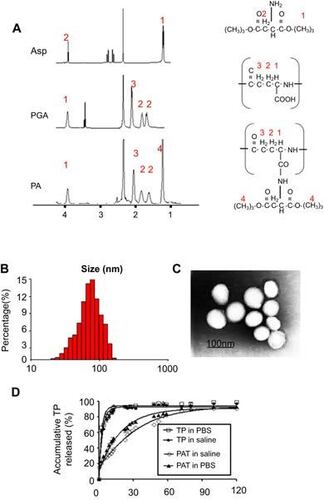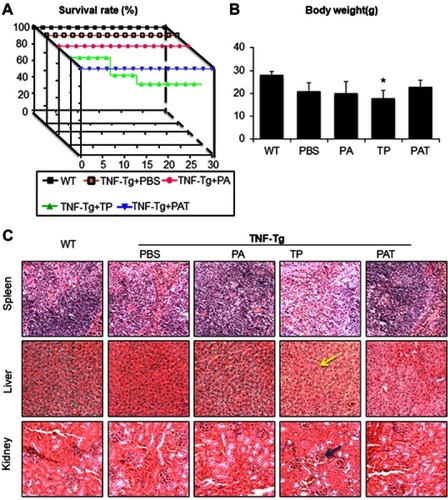Zhang L, Chang J, Zhao Y, et al. Int J Nanomedicine. 2018;13:2051–2064.
Following a review of their data post-publication, the authors found errors in on page 2055 and the Liver WT and PAT images used for on page 2059. For accuracy and experimental integrity these images have been corrected, with no impact to the conclusions of the study. The authors apologize for this error.
The corrected figures:
Figure 1 Characterization of PAT. (A) 1H NMR spectra of Asp (1), PGA (2), and PA (3) dissolved in deuterium generation reagent DMSO and were recorded on a 1H NMR spectrometer. The nano-size of PAT was detected by (B) DLS and (C) TEM. (D) The control released manner of TP from PAT. Free TP or PAT was dissolved in dialysis bag (10KD) and shacked in 37°C, 60 turns/min.
Abbreviations: Asp, Di-tert-butyl L-aspartate hydrochloride; PGA, poly-γ-glutamic acid; PA, PGA-grafted Asp; TP, triptolide; PBS, phosphate buffer saline; PAT, TP-loaded PGA-grafted Asp; NMR, nuclear magnetic resonance; DMSO, dimethyl sulfoxide; DLS, dynamic light scattering; TEM, transmission electron microscopy.

Figure 4 PAT protects mice from the toxicity of TP. (A) The survival rate of different groups show PAT increased the survival rate of TNFα-Tg mice, compared with TP treatment. (B) The body weight of different groups at the last day of treatment shows PAT significantly prevented the body weight loss of TNFα-Tg mice, compared with TP treatment. Values are the mean ± SD of 7–10 mice per group. (C) HE staining sections (magnification ×200) of the liver, spleen and kidney show PAT protected those organs from injury caused by TP. The yellow arrow indicates the hepatic nucleus, and the blue arrow indicates the renal glomerulus. *P,0.05, vs TP group.
Abbreviations: WT, wild type; TNFα-Tg, tumor necrosis factor α transgenic; PBS, phosphate buffer saline; PA, poly-γ-glutamic acid-grafted di-tert-butyl L-aspartate hydrochloride; TP, triptolide; PAT, TP-loaded poly-γ-glutamic acid-grafted di-tert-butyl L-aspartate hydrochloride; HE, hematoxylin–eosin.

